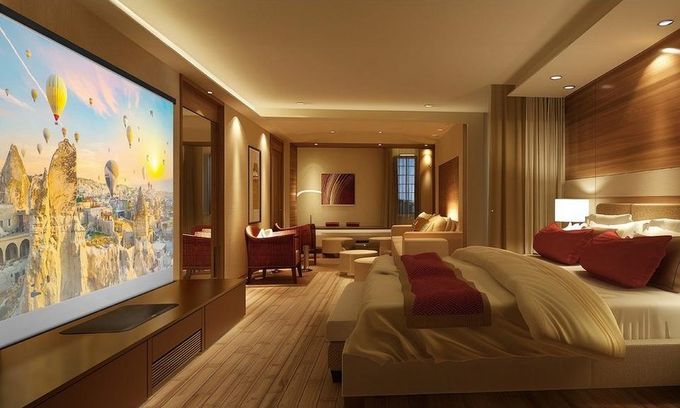For several years now, ultra-short throw (UST) projectors have been one of the drivers of development in the projector segment, actively replacing traditional TVs in living rooms. Their popularity as an alternative to TVs is due to several factors.
As known, mid-focal projectors form a lardge projection from a distance of several meters. But their placement in the room center creates the problem of wires on the floor, which today is effectively solved only with the help of a ceiling mount. Unfortunately, this solution is troublesome, expensive, and, most importantly, radically limits the projector mobility. Its owner is unlikely to remove the projector from the ceiling to watch baseball in the yard with friends, beer and chips.
Until recently, high price was the second major problem with 4K projectors. Of course, 1080p models are significantly cheaper, but consumers are already accustomed to crisp 4K images on TVs.
The pixel shift technology and UST projectors have successfully solved both problems.
UST projector and Pixel Shift
UST models use a cascade of internal lenses and an aspherical reflective lens, forming an image of 100″ or more diagonally from a distance of only a few dozen cm. Accordingly, the placing of the projector close to the screen does not create a problem with wires.

To be fair, the impressive dimensions of UST models also limit their portability, but carrying a device weighing 10-15 kg is clearly easier than dismantling a ceiling mount.
Pixel shift or ‘4Ke’ was another technological breakthrough, radically reducing the price of 4K projectors. Epson replaced very expensive 4K LCD chipsets with much cheaper 1080p, compensating for the resolution reduction using the shift algorithm. In fact, this technology shifts each pixel diagonally, doubling an effective resolution.
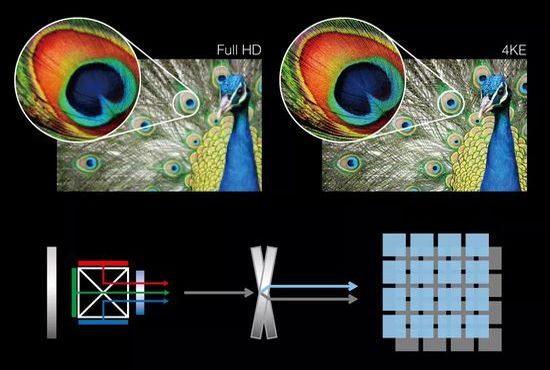
Latest Epson models use 4K PRO-UHD advanced pixel-shifting which increases detail and clarity without sacrificing picture brightness.
Of course, manufacturers of DLP (Digital Light Processing) projectors did not stand aside either. As known, Texas Instruments dominates this segment, developing DMD (Digital Micromirror Device) chipsets for DLP projectors. Several years ago, the company developed pixel-shift-based XPR (Xpanded Pixel Resolution) technology. Its operation principle is simple and elegant. The projector divides 8 million pixels of 4K content into four parts (4 phase pixel shift). Then, the 2 million micromirrors of the relatively cheap 1080p chipset sequentially display four 1080p images, shifting them half a pixel relative to each other. Strictly speaking, the projector displays only one 1080p image at any given time. But due to the high frequency, the vision and brain perceive them as one picture with a higher resolution. The pixel shift is carried out by tilting the lense using four XPR module magnets.
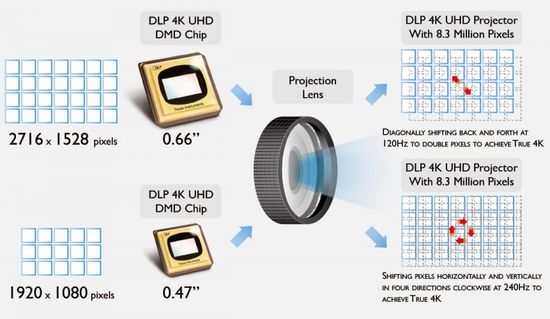
UST projector vs huge TV
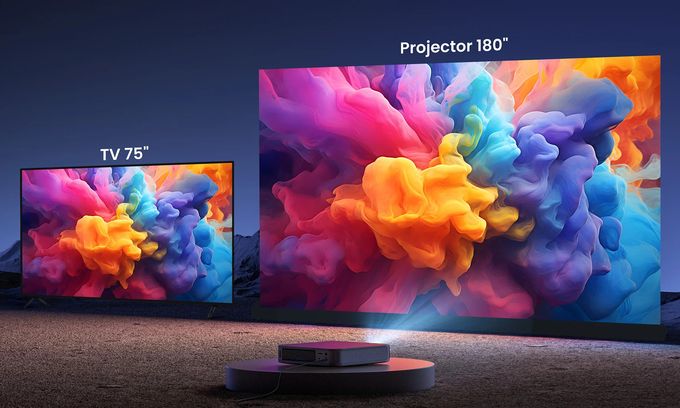
As a result, UST projectors are increasingly occupying a place in living rooms. But honestly, this aspect has nuances.
A few years ago, UST projectors triumphantly burst onto the market, offering a huge image at a relatively cheap price. Indeed, the price of 100-inch TVs started at $ 15,000, which blocked the mass segment for them. But not wanting to lose a promising niche, the leaders of the TV industry, including Samsung, LG, Hisense and TCL concentrated their efforts on huge TVs. As a result, today the market is already filled with superb 100-inch models, the price of which varies from $ 2,500 to $ 5,000. Moreover, the new 98-inches TCL QM6K is available for only $ 2,400.
Of course, many projectors offer from 120 “to 200” diagonally. But this bonus is controversial. Firstly, increasing the image size requires increasing the projector brightness. Therefore, the max size specified in the specs actually characterizes only the focusing range. At the same time, companies often additionally indicate that the recommended size for the declared high quality is only, for example, 120 “or 130”. In reality, it depends on the projector brightness and the ambient light.
In addition, the optimal viewing distance recommended by ophthalmologists is the screen diagonal with a multiplier of 1.3. Thus, even a 130-inch screen requires a viewing distance of 4 meters. Perhaps this is not a problem in a villa near the ocean, but it can be a difficult task for a living room in a standard city apartment. These factors slightly reduce the bonus of projectors in the max image size. But in any case, consumers can only welcome healthy competition between UST projectors and huge TV panels.
DLP vs 3LCD brightness
Epson mainly uses 3LCD projection technology, which provides higher brightness vs DLP projectors. As known, DLP projectors generate colors using a color wheel. At any time, the color filters of its segments pass only one color at any time, blocking the other two. Of course, this process is accompanied by a loss in the color brightness, and their CLO (Color Light Output) is always lower vs white brightness. Epson 3LCD projectors do not use a color wheel, creating an color image without colors brightness loss. Transmitting light only of a certain frequency (color), their mirrors divide the white light stream into red, green and blue RGB components, directing them to the corresponding monochrome LCD matrixes. In tern, they form at the output black-red, black-green and black-blue images that are sent to prism, are combined into a full color image and sends to the optical system. In this case, colors brightness is not reduced.
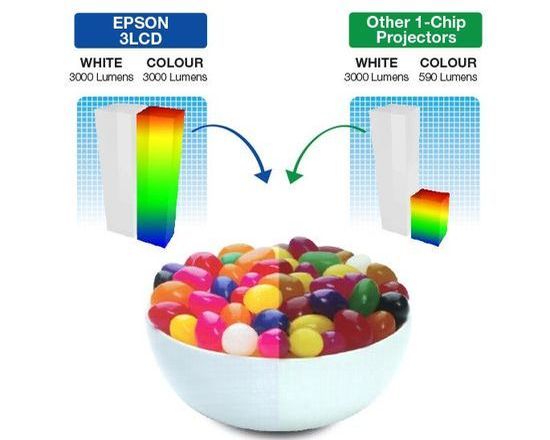
A few years ago, Epson suggested using CLO for a more objective assessment of the projector brightness. Unfortunately, this idea was not implemented.
As a result, companies today use lumens, ANSI lumens (American National Standards Institute, the luminous flux at nine points on the screen), ISO lumens (ISO 21118 standard, 1 ANSI lumen ~ 0.8 ISO lumens), LED lumens (1,000 LED lumens ~ 417 ANSI lumens) and CVIA lumen (China Electronics Video Industry Association, 1 CVIA lumen ~ 2 ANSI lumens). Not wanting to risk their reputation, in recent years some companies choose not to specify brightness in specs. But the free market requires sacrifices, and the unification is one of its problem.
Epson QS100
Today, the Epson EpiqVision Ultra UST 4K projector lineup includes LS300, LS500, LS650, Epson PowerLite 810E / 815E and LS800 projectors.
The latest LS800 was introduced in September 2022. At a white/color brightness of 4,000 ISO lumens, it costs ~$ 3,000 today. This year, the company is replacing it with the QS100 with launch price of $ 4,999 MSRP. According to the company, the developers have addressed some of the shortcomings of the LS800, including the lack of IP control, calibration control and panel alignment tools, slow Android boot-up speed and HDMI control issues.
In addition to eliminating cons, the developer has increased the brightness to 4,500 ISO lumens. It’s quite enough to reproduce bright saturated colors on a 160-inch diagonal screen even in diffuse daylight without additional dimming. According to Epson, the model uses a new 5-in-1 laser light source module. In addition, its 32-bit QZX Picture Processor provides frame interpolation, effectively enhances contrast, brightness and color accuracy. The projector provides 1,800:1 native contrast (FOFO – full-on / full-Off) and 5,000,000:1 dynamic contrast.
HDR performance is also enhanced by an advanced dynamic tone mapping feature with frame-by-frame HDR level optimization. The model uses full 10-bit HDR color processing and supports HDR, HDR10, and Hybrid Log Gamma formats.
Input lag with Auto Low Latency Mode (ALLM) does not exceed 26 ms, which is quite enough for smooth gaming even in ‘heavy’ games.
The projector is compatible with Crestron, Control4, or any PJLink-compatible control system. Once configured, the projector can be controlled via remote control, touchpad, or voice control systems.
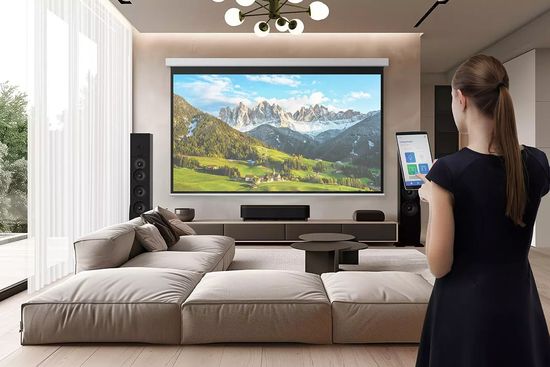
Finally, the model is compatible with integrated cabinets, for example, from Salamander Designs. In this case, the projector will fit harmoniously into any interior.
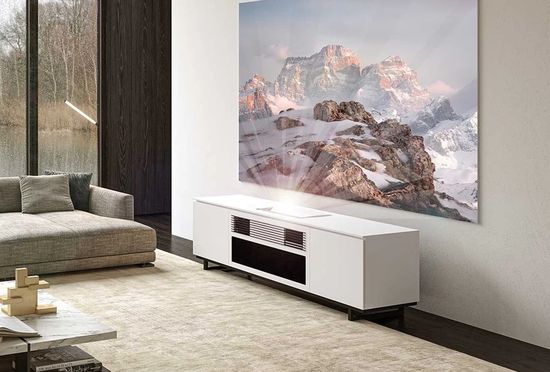
Conclusion
The Japanese giant has once again expanded the range of its UST projectors with the Epson QS100. In fact, it replaces the LS800 (2022), eliminating its cons (improved IP / calibration control and panel alignment tools) and significantly increasing the brightness. Unfortunately, the price has also increased. In particular, its launch price is $ 4,999 MSRP vs ~ $ 3,000 for the LS800. But a traditional adjustment of the launch price can lower it. A partial list of new competing UST 4K models includes:
– Samsung The Premiere 9 LPU9D 4K UST – $ 5,900, DLP, 3,200 ANSI Lumens, RGB Laser (110% BT.2020 color gamut), 1,800:1 FOFO contrast, 40W 2.2.2ch audio;
– NexiGo Aurora Pro MKII 4K UST – $ 3,500, DLP, 2,400 ANSI Lumens, ALPD 5.0 RGB+ (110% BT.2020 color gamut), 4.2 ~ 8ms Input lag, 4,000:1 FOFO contrast;
– Hisense PX3-PRO 4K UST – $ 3,500, DLP, RGB Laser (110% BT.2020), 3,000 ANSI Lumens, 3,000:1 FOFO contrast;
– Formovie Cinema Edge 4K UST – $ 1,800, DLP, RGB Laser (110% BT.2020), 1,900 ISO Lumens, 3,000:1 FOFO contrast.
With the exception of low-brightness relatively cheap models, their prices start at $ 3,500. Considering the very high brightness of up to 4,500 ISO lumens (including CLO with 3LCD techology), the $4,999 MSRP seems quite reasonable for a bright premium UST 4K projector. In fact, it delivers bright, saturated colors for a 160-inch projection even in ambient daylight. In addition, the impeccable reputation of the Japanese old-timer also deserves a decent price.
Video introduces the new Epson QS100 4K PRO-UHD 3LCD UST laser projector.
